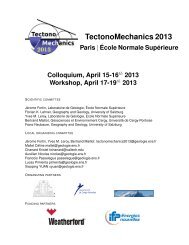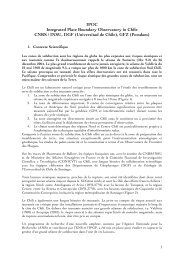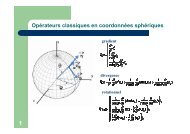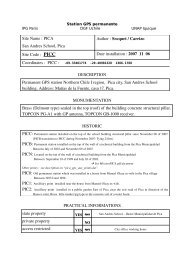PDF file - Laboratoire de Géologie de l'Ecole normale supérieure - Ens
PDF file - Laboratoire de Géologie de l'Ecole normale supérieure - Ens
PDF file - Laboratoire de Géologie de l'Ecole normale supérieure - Ens
You also want an ePaper? Increase the reach of your titles
YUMPU automatically turns print PDFs into web optimized ePapers that Google loves.
ARTICLES NATURE|Vol 436|14 July 2005<br />
Figure 1 | Co-seismic displacement field <strong>de</strong>rived from GPS observations at<br />
more than 60 sites. Panel a shows a large scale overview from a low-<strong>de</strong>nsity<br />
subset. Panel b provi<strong>de</strong>s more <strong>de</strong>tail, zooming in on a smaller area<br />
(rectangular box in a). Note the high-<strong>de</strong>nsity sub-network on the Malaysian<br />
peninsular. Bold numbers next to arrow heads give the displacement in mm.<br />
peninsula (2 cm in Singapore, 17 cm in Langkawi island) suggests a<br />
limited amount of slip on the southern section of the fault.<br />
Elastic co-seismic mo<strong>de</strong>lling<br />
Observed surface displacements are mo<strong>de</strong>lled using Okada’s formulation<br />
of a dislocation buried in an infinite elastic half-space 5 . A first<br />
mo<strong>de</strong>l (mo<strong>de</strong>l A) was constructed using the USGS 6 and CMT 7<br />
parameters: localization, <strong>de</strong>pth, focal mechanism and magnitu<strong>de</strong>.<br />
202<br />
Ellipses <strong>de</strong>pict the 90% confi<strong>de</strong>nce level. Thin black lines <strong>de</strong>pict major<br />
faults 8 . The USGS earthquake epicentre location is portrayed by the star<br />
symbol, near bottom left of box. ETOPO-5 and GTOPO-30 Digital Elevation<br />
Mo<strong>de</strong>ls were used to generate the background topography and bathymetry.<br />
To match these parameters, we assume a rectangular dislocation<br />
plane of 450 km length and 145 km width, dipping with an angle of 88<br />
and emerging at the surface roughly along the trench. Assuming a<br />
rigidity coefficient of 4 £ 10 11 GPa, a uniform slip of 12 m perpendicular<br />
to the trench direction gives a total seismic moment of<br />
3 £ 10 22 N m and a moment magnitu<strong>de</strong> M w ¼ 9.0, in agreement<br />
with the CMT value. With an average misfit of 27 mm this mo<strong>de</strong>l<br />
matches well the observed <strong>de</strong>formation in northern Sumatra<br />
© 2005 Nature Publishing Group<br />
Figure 2 | Elastic mo<strong>de</strong>lling of<br />
co-seismic <strong>de</strong>formation. GPS results<br />
(black arrows) and mo<strong>de</strong>l predictions<br />
(white arrows) are shown. Grey<br />
rectangles <strong>de</strong>pict mo<strong>de</strong>ls for rupture<br />
planes buried at <strong>de</strong>pth (see text for<br />
<strong>de</strong>tails). Grey arrows show the<br />
mo<strong>de</strong>lled direction and amount of<br />
slip. Mo<strong>de</strong>l A (panel a) uses a 450-kmlong<br />
rupture and mo<strong>de</strong>l B (panel b)<br />
uses a 1,000-km-long rupture, curved<br />
along the trench in two segments.<br />
x and y axes show distance (km) in a<br />
UTM (Universal Transverse<br />
Mercator) projection.






